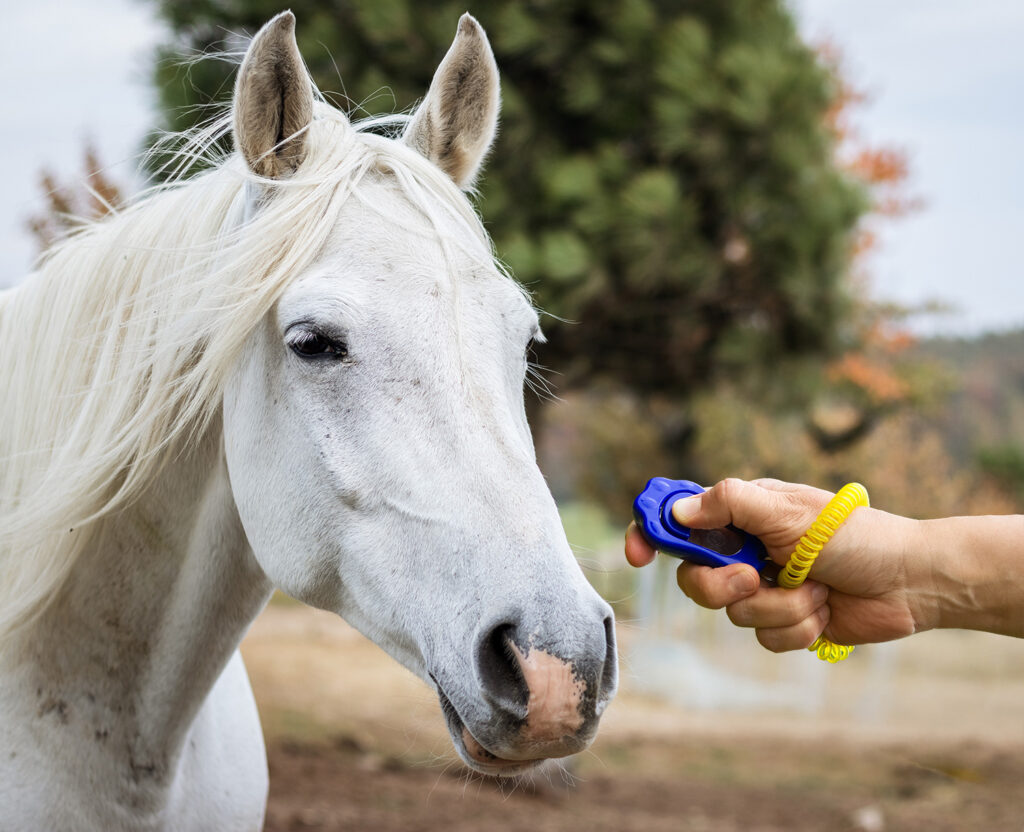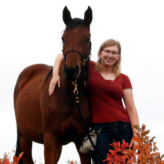As the official nutrition partner of Equestrian Canada, Mad Barn extends our appreciation for featuring this story. To read the full version, visit https://madbarn.ca/clicker-training
Written by: Dr. Madison Ricard, DVM, PhD, DACVP, PAS
Reviewed by: Dr. Christine Latham, Ph.D.
Clicker training is a positive reinforcement technique that helps horses learn new behaviours through clear communication and rewards.
Using a small handheld device that makes a distinct clicking sound, trainers can mark desired actions and immediately follow up with a treat or praise. This method strengthens the horse-human bond, encourages problem-solving, and enhances training sessions by making learning enjoyable and stress-free.
Whether teaching basic manners or advanced tricks, clicker training offers a gentle, effective way to develop a willing and responsive equine partner.
What is Clicker Training?
In clicker training, trainers use a defined signal or sound (usually a “click” from a small handheld device) to indicate to the animal that they have performed the correct action. The animal is then given a reward such as a treat or toy.
This process is called respondent conditioning. With repetition, the animal learns that the conditioned reinforcer (the click) denotes a correct response. By using a short, well-defined signal, trainers can quickly “mark” changes in the animal’s behavior without needing to have the reward immediately accessible.
Once the animal understands the purpose of the conditioned reinforcer, trainers can use the click to shape a desired behavior. Shaping involves breaking a desired behavior down into its component pieces or small steps, so that each step builds on the previous and the animal can learn complex behaviors systematically.
Benefits
Research on training methods in horses is limited, but studies suggest positive reinforcement has several advantages over negative reinforcement. Horses trained with positive reinforcement show greater motivation to enter the training area, interact more with trainers, and display more curiosity.
They also perform better in desensitization tasks and adapt more quickly to novel objects. Additionally, positive reinforcement has been shown to shorten trailer-loading times and reduce related stress.
Applications
Clicker training applications range from teaching simple tricks to training complex maneuvers. Potential applications for clicker training for horses include:

How to Start Clicker Training Your Horse
Getting started with clicker training requires choosing a reinforcer and a reward, then developing a training plan for your first task.
1. Choose a Reinforcer
Key features of an effective conditioning reinforcer include:
- Speed: Make the noise instantly when you recognize a desired behavior or progression.
- Novelty: The horse should not hear the noise in its daily routine or previous management, only within the context of your training or handling sessions.
- Repeatability: The sound must be consistent each time to avoid confusion.
Most clicker trainers find it easiest to use a mechanical clicker when they are starting out. This is a small device that makes a loud, repeatable clicking noise when pressed. Many pet stores sell clickers, as they are a common training tool for dogs.
It is important that the clicking noise is distinct from the “cluck” commonly used to encourage a horse to move forward, as horses have often already been conditioned to this noise.
2. Select a Reward
Next, select what type of reward you want to give your horse. Food is a common reward, as horses are instinctively driven to seek out food. Example food options for clicker training include:
- Hay pellets or cubes
- Chaff
- Oats
- Small pieces of carrots or apples
- Commercial pelleted feeds
- Commercial horse treats marketed for horse training
- Handfuls of grass or hay
Other positive stimuli, such as scratches or rubs, can also be suitable rewards. The key is that your particular horse must find the reward motivating enough to seek it out.
3. Condition the Reinforcer
Once you have chosen your reward and reinforcer, clicker training begins with conditioning the reinforcer. This process teaches the horse that the signal means “Yes, you did it!” and indicates a reward will follow shortly.
To condition the reinforcer, simply click and then give your horse a treat. Repeat this until the horse starts to expect a treat when they hear the click. You may need to repeat this process over a few days to develop a strong response to the click.
Training a Simple Task
After conditioning the reinforcer, you can start to use it to shape behaviors. Before starting a training session, break down the desired behavior into simple, small steps. The first step should either be a known behaviour or something that the horse can “accidentally” perform without guidance.
For your first session, start with a simple task, such as touching their nose to an object. To shape this behaviour into a consistent response to the object, conditioning the horse may follow these steps:
- Horse bumps its nose into an object held 1-2 inches from its head out of curiosity
- Horse seeks out touching an object held 1-2 inches from its head
- Horse seeks out touching an object held 1-2 feet from its head
- Horse seeks out touching an object on the ground, on a wall, or held at a distance, requiring the horse to move its head and neck
- Horse walks to an object to touch it
By clicking and rewarding, the behavior “touch the object” can be captured. By building on this behavior over time, you can develop distance, time, and additional required movement using the command.
It is important that your horse masters each step before proceeding to the next. During the initial training period, every successful effort by the horse should be followed by a click and reward. This consistent reinforcement schedule encourages participation in the training process and development of the behaviour.
Once your horse has mastered a behaviour, you can reduce the frequency of the click-and-treat reward system. If you notice that your horse is struggling with a step, return to the previous step and ensure mastery before moving on again.
About Dr. Madison Ricard, DVM, PhD, DACVP, PAS
Dr. Madison Ricard graduated from the University of Calgary Faculty of Veterinary Medicine in 2020, and holds a PhD in Anatomic Pathology from the Western College of Veterinary Medicine in Saskatoon, SK. Madison’s veterinary health and research interests primarily focus on horses, particularly equine reproduction. Currently, her herd consists of several retired show jumpers, a show jumping prospect, and two goats.

